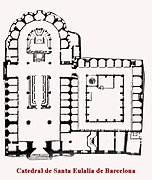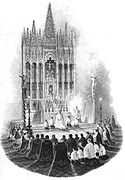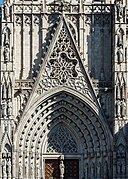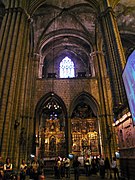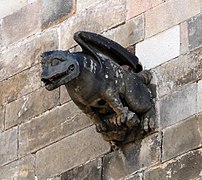Barcelona Cathedral
- Not to be confused with Sagrada Família, which is a large church by Antoni Gaudí, also in Barcelona
| Cathedral of the Holy Cross and Saint Eulalia | |
|---|---|
| |
 | |
| Religion | |
| Affiliation | Roman Catholic |
| Province | Archdiocese of Barcelona |
| Ecclesiastical or organizational status | Cathedral |
| Leadership | Lluís Martínez Sistach |
| Year consecrated | 1339 |
| Status | Active |
| Location | |
| Location | Barcelona, Catalonia, Spain |
| Geographic coordinates | 41°23′02″N 2°10′35″E / 41.38389°N 2.17639°E |
| Architecture | |
| Type | Church |
| Style | Gothic, Gothic Revival |
| Groundbreaking | 1298 |
| Completed | 1420 ; façade and central tower, 1913 |
| Specifications | |
| Length | 90 metres (300 ft) |
| Width | 40 metres (130 ft) |
| Height (max) | 53 metres (174 ft) (2 towers) |
| Website | |
| www.catedralbcn.org | |
The Cathedral of the Holy Cross and Saint Eulalia (Template:Lang-ca, Template:Lang-es), also known as Barcelona Cathedral, is the Gothic cathedral and seat of the Archbishop of Barcelona, Spain.[1] The cathedral was constructed from the 13th to 15th centuries, with the principal work done in the 14th century. The cloister, which encloses the Well of the Geese (Font de les Oques) was completed in 1448.[2] In the late 19th century, the neo-Gothic façade was constructed over the nondescript exterior that was common to Catalan churches.[3] The roof is notable for its gargoyles, featuring a wide range of animals, both domestic and mythical.
It is a hall church, vaulted over five aisles, the outer two divided into chapels. The transept is truncated. The east end is a chevet of nine radiating chapels connected by an ambulatory. The high altar is raised, allowing a clear view into the crypt.

The cathedral is dedicated to Eulalia of Barcelona, co-patron saint of Barcelona, a young virgin who, according to Catholic tradition, suffered martyrdom during Roman times in the city. One story says that she was exposed naked in the public square and a miraculous snowfall in mid-spring covered her nudity. The enraged Romans put her into a barrel with knives stuck into it and rolled it down a street (according to tradition, the one now called Baixada de Santa Eulàlia). The body of Saint Eulalia is entombed in the cathedral's crypt.
The choir stalls retain the coats-of-arms of the knights of the Order of the Golden Fleece. In his first trip into Spain, Charles, the future Holy Roman Emperor, selected Barcelona as the site of a chapter of his Order. The king had arrived for his investiture as Count of Barcelona, and the city, as a Mediterranean port, offered the closest communication with other far-flung Habsburg dominions, while the large proportions of the cathedral would accommodate required grand ceremonies. In 1518 the Order's herald, Thomas Isaac, and its treasurer, Jean Micault, were commissioned to prepare the sanctuary for the first sitting of the chapter in 1519. Juan de Borgonya executed the painted decoration of the sanctuary.
The side Chapel of the Holy Sacrament and of the Holy Christ of Lepanto contains a cross said to date from the time of the Battle of Lepanto (1571).[4]
In addition to Saints Eulàlia and Olegarius, the cathedral contains the tombs of Saint Raymond of Penyafort, Count Ramon Berenguer I and his third wife Almodis de la Marche, and bishops Berenguer de Palou II, Salvador Casañas y Pagés, and Arnau de Gurb, who is buried in the Chapel of Santa Llúcia, which he had constructed.
The cathedral has a secluded Gothic cloister where 13 white geese are kept, the number explained by the assertion that Eulalia was 13 when she was martyred.[4]
A program of cleaning and restoration of the cathedral was carried out from 1968-72.[5]
History
Parts of an early Christian and visigothic episcopal complex including the baptistery (4th century), a basilical hall (5th century), a cross shaped church (6th-7th century) and bishop's palace (6th-7th century) are displayed in the Barcelona City History Museum archaeological underground. Reportedly, this Visigothic chapel was dedicated to Saint James, and was the proprietary church of the Viscounts of Barcelona.[6] However, in a document from the Second Council of Barcelona in 599, it states that the cathedral was dedicated to the Holy Cross.[2] This church was severely damaged by al-Mansur (Almanzor) during his attack on Barcelona in 985.
In 1046, Count Ramon Berenguer I and his wife Almodis, together with Bishop Guislabert, began construction of a Romanesque cathedral at the site; it was consecrated in November 1058.[2] The cathedral was constructed over the crypt of the former church. It has been reported that a Viscount of Barcelona, Mir Geribert, sold the site to Bishop Guislebert in 1058,[6] however this date does not coincide with the reported start of construction.
The present Gothic cathedral was begun on the foundations of the previous churches on 1 May 1298; James II the Just was King of Aragon at the time, and Bernat Pelegri was Bishop of Barcelona. The church was built from the east end towards the west end, with a simple west facade completed in 1417. The cloister was completed in 1448, making the total duration of construction 150 years. In the late 19th century, Miguel Girona i Agrafel offered to complete the neo-Gothic facade and central tower as inspired by the original 15th-century design prepared by master Carlí and rearranged and drawn by the architect Josep O. Mestres. This work was completed in 1913 by Girona's children.[2]

Chapel of Lepanto
The Chapel of the Holy Sacrament and of the Holy Christ of Lepanto is a small side chapel constructed by Arnau Bargués in 1407, as the chapterhouse. It was rebuilt in the seventeenth century to house the tomb of San Olegarius, Bishop of Barcelona and Archbishop of Tarragona.
The "Holy Christ of Lepanto" crucifix, is located on the upper part of the chapel entrance's front façade. The curved shape of the body is explained by a Catalan legend which holds that the cross was carried on the prow of the galley captained by Juan of Austria, step-brother of Spanish Philip II of Spain during the Battle of Lepanto in 1571. When a cannonball flew toward the cross, it leaned out of the way in order to avoid being hit, and has been inclined ever since.[7] The Habsburgs were said to have regarded this as an encouraging omen.
A separate story says that the cross was in the ship's hold and that the figure moved to cover a large hole that would have sunk the ship.[8]
Traditions
- The tradition of the 'Dancing egg' is maintained on the day of Corpus Christi at the cathedral.
Images
-
Cathedral plan
-
Illustration of the main altar (1839)
-
Main portal
-
Door in the cloister
-
Chapels
-
Santa Eulàlia's Crypt
-
Cloister
-
Geese in the cloister
-
Choir seats at the Cathedral
-
The Fountain in the Atrium of the Santa Eulalia
-
The Cathedral garden
-
Gargoyle
-
Tomb of Saint Raymond of Penyafort
-
Scale model of the cathedral, at the Catalunya en Miniatura park
-
Bell Tower with stair turret above the door of Saint Ivo.
References
- ^ Though sometimes inaccurately so called, the famous Sagrada Família is not a cathedral
- ^ a b c d http://www.catedralbcn.org/
- ^ Edward Steese, "The Great Churches of Catalonia" Parnassus 7.3 (March, 1935:9-12) p. 9.
- ^ a b Patterson, Margot (2004-04-01). "To build a cathedral is immense, crazy work". National Catholic Register. Retrieved 2007-01-12.
- ^ Detailed in Juan Bassegoda Nonell, La catedral de Barcelona: su restoración 1968-1972 (Barcelona).
- ^ a b F. Carreras Candi La Ciutat de Barcelona
- ^ This is said to have inspired the Habsburg forces to victory.O'Shea, Henry. A Guide to Spain, London, Spottiswoode and Co., 1865
- ^ "Holy Christ of Lepanto", Catedral de Barcelona

